Chapter 03
Captain John Smith was very skillful and resourceful, saving the Plymouth Colony from starvation and destruction by the Native Americans. He negotiated with Powhatan for food and supplies. As the leader of Jamestown,he charted the coast and wrote the first American book, A True Relation. He was "saved" by Pocahontas.

Captain John Smith (PENG)
Powhatan was a Native American chieftain (and father of Pocahontas). He ruled 13,000 to 34,000 people of the Powhatan nation and was not alwyas in favor of the Jamestown colony settlers. However, after his daughter married John Rolfe, he mantained civil relations with them.
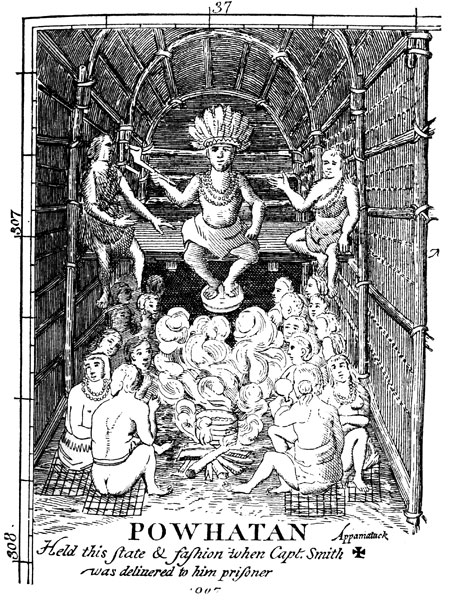
Powhatan (VEERAMANI)
John Rolfe is immortalized by being the husband of Pocahontas. He was a Jamestown settler, and his lesser known claim to fame is for being the first to successfully grow tobacco in the middle Americas.

John Rolfe (VEERAMANI)
Became King of England in 1603; eyed North America as a possible location for ENglish colonists that could be as profitable as the Spanish colonies. He granted the Virginia Company over 6 million acres in north Americaa.

James I (PENG)
Appointed colonial governor of Virginia in 1641.Defeateed Native Americans and Dutch, extended explorations, encouraged agriculture, supported King Charles I, declined to recognize common wealth. Temporarily forced to flee due to Bacon's Rebellion.

William Berkeley (PENG)
member of Virginia Council, organized Bacon's Rebellion, a civil revolt that sprang from Colonial disagreement over response to Indian uprising.These forces violated Berkeley's orders and took indiscriminate action against Indian tribes. When Berkeley removed him from council seat, Bacon burned Jamestown and forced Berkeley to flee. Bacon's Laws were a series of reforms measures passed by the new legislature that favored local settlers.

Nathaniel Bacon (PENG)
The Pueblo Indians were a group of Native Americans living in the Southwestern US. They were the first group to successfully try to overthrow the Spanish (in the Pueblo Revolt of 1680) which kept the Spanish away for 12 years. There are many subgroups of the Pueblo, but the most notable are the Hopi, Acoma, and Zuni. They are descended from the Anasazi.

Pueblo Indians (VEERAMANI)
His reign marked the REstoration Period-restoration of monarch after republic under Oliver cromwell. He had a reputation as a hedonistic rogue and having several mistresses. War with the Dutch, fights with Parliament over finances, a bad wave of the Bubonic plague (1665), the Great Fire of London (1666) highlighted his reign. He also gave a Barbados team a charter to establish a colony south of the Chesapeake; they eventually established Charleston.

Charles II (PENG)
The Virginia Company was started by James I to finance the colonization of the Americas (eastern coast). Its investors were usually wealthy Londoners who usually ended up making no money off of the investment. The company financed the Jamestown settlement, but broke apart in 1624.

Virginia Company (VEERAMANI)
Colonization is the act of controlling (politically and economically) another land area, while keeping dominance over the natives of the country.

colonization (VEERAMANI)
Jamestown was the first permanent British settlement in the Americas. It was located in present day southern Virginia. It became the capital in 1619, but was almost annihilated in Bacon's Rebellion, and waned after Williamsburg became the capital in 1700.

Jamestown (VEERAMANI)
The Royal Colony was under the control of the King of England. The king appointed a governor to "rule" in his stead and a council to serve as a sort of small Parliament. By the time of the American Revolution, the Royal colonies were New York, New Hampshire, Massachusetts, New Jersey, Virginia, North Carolina, South Carolina, and Georgia.

Royal colony (VEERAMANI)
The House of Burgesses was the lower governing body in Virginia (in the colonial era). It was the first representative-based ruling house in a British colony.

House of Burgesses (VEERAMANI)
Tobacco is native to the New World (Americas) and was grown as a chief cash crop to the English settlements on the Eastern coast of the (now) United States. It was important because it offset the costs of bringing people to America and served as a valuable trading asset.

tobacco (VEERAMANI)
Introduced by the Virginia Company, it promised that males who could pay their passage across the Atlantic would be give 50 acres of land. In addition, their servants and sons each receive 50 acres as well.

headright system (VEERAMANI)
Indentured servants took part in a system that gave poor European immigrants the opportunity to travel across the Atlantic to the Americas for the price of 4-7 yeats of labor. During that servitude period, they were provided with food and shelter. It was a contract.

indentured servants (VEERAMANI)
a "free" man who owned and sometimes worked his own farm; he did not own slaves, his acreage was small, and he was usually a small-time family farmer.
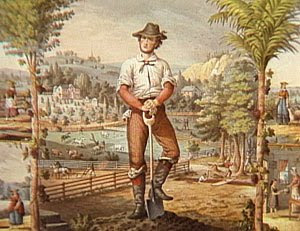
yeoman farmers (VEERAMANI)
The Navigation Acts were passed by Parliament first in 1660, and they stated that British-controlled colonies in Asia, Africa, and America could only trasport (and trade) their goods on English ships. Its motives were to give Britain a monopoly on American crops such as tobacco, and to keep the competition (namely the Dutch) at bay.

Navigation Acts (VEERAMANI)
(essentially, the "policies of merchants") Mercantilism is the economic policy that swept through Europe after the feudal days, where countries used governmental interference to keep their economies thriving, usually through selling to foreign markets. It also employed colonization, development, mining, and balanced trade.

Mercantilism (VEERAMANI)
Uprising in Virginia led by Nathaniel Bacon in response to high taxes, low prices for tobacco, resentment against special privileges to given to elite planters, and Berkeley's failure to defend the frontier against Native AMericans. Bacon's forces declared war against Berkeley and other grandees, fought the Indians, sacked the grandees' plantations, attacked Jamestown. The rebellion resulted in greater royal control of colony and lessened tensions between great planters and small farmers.

Bacon's Rebellion (PENG)
Form of business that is a combination of a corporate and partnership deal. All of the owners are given shares of their own to do whatever they wish with, but all owners are also responsible the debts that the company incurs.

joint-stock company (VEERAMANI)
"starving time" was the period during the winter of 1609-1610 where the settlers of Jamestown had almost no sustenance. A couple of them even resorted to eating their recently-dead neighbors. When new colonists (being pushed by the Virginia Company) arrived at the colony in the spring of 1610, only 50 out of the original 600 colonists were still alive.
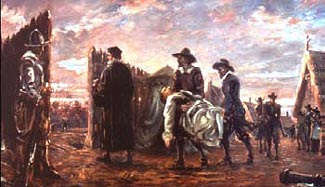
"starving time" (VEERAMANI)
Most newcomers to VIrginia were gentlement and their servants, rathers than farmers, whose breeding and quality proved worthless for growng corn, catching fish, or even hunting dear. They traded instead of worked with their hands in the farm. Thus, the early settlers depended on the Native Americans for food.
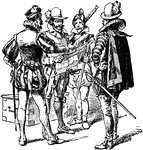
"gentlemen settlers" (PENG)
(also Indian Massacre of 1622) Chief Opechancanough (of the Powhatan Confederacy) ordered a series of attacks on the Jamestown colony, where the Native Americans used any weapons available to kill 347 colonists. He was Powhatan's brother.

Opechancanough's Raid (VEERAMANI)
Poor English folk who aspired to immigrate to the New World (but financially couldn't) and the colonists' crying need for labor formed the context for the creation of the servant labor system. Poor immigrants agreed to a contract called an indenture, where they were committed to four to seven years of labor in exchange for passage to the colonies and food and shelter after they arrived. Men, women, whites, and blacks participated.

servant labor system (PENG)
A frontier is a borderland area. It refers to the dividing line between the Native Americans and the Europeans who inhabited their land.

frontier (VEERAMANI)
Most of the Chesapeake colonists were Protestants by name. Church attendance was mandatory, but not many clergymen had migrated to the Americas. Some took their religion seriously, but for many of them, it was not very central to life.

religion in the Chesapeake region (VEERAMANI)
1632, King Charles I granted Catholic Lord Batlimore 6.5 million acres n northern Chsapeake region (Maryland). His goal to was create a refuge for Catholics, who were discriminated in England. However, the colony was mostly Protestant settlers. The Catholics were minorities but were wealthy and prominent.

Maryland Colony (PENG)
The planter elite was a class of wealthy owners of huge plantations who had twenty or more slaves working on their land.

planter elite (VEERAMANI)
Chesapeake Society was principally divided between free farmers and unfree servants. On the whole, a rough, frontier equality characterzed free families. However, cheap tobacco and declining mortality rate led to increased landless freemen. The planter elite/landowners viewed landless colonists as a dangerous rabble.

freemen (PENG)
Spanish missionaries were attracted to New Mexido and FLorida, seeking to harvest Indian souls. Royal officials hoped missionaries would pacify Indians and be a realtively cheap way to preserve SPanish footholds in North America. However, the coercive methods provoked Indian retaliation against Spanish exploitation.
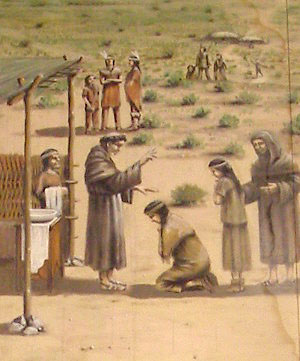
Spanish missionaries (PENG)
As Spaniards and Portuguese suplemented Indian laboreres with enslaved Afrcans, European colonzers built African slavery into the most important form of coerced labor.ENglish colonies in WEst Indies developed sugar plantations with slave labor and Chesapeake tobacco fields began to replace servant with slave labor.

slave labor system (PENG)
Barbados was highly successful in growing sugarcane and exporting great amounts to Europe. However, thousands of African slaves were shipped over to plant, cultivate, and harvest sugarcane on teh plantations. Their living conditions were miserable, but were vital to the success of sugar plantations.

sugar plantations (PENG)
The WEst Indies was the most profitable part ofthe English New World empire in the seventeenth century due to the highly profitable sugar plantations. Slaves constituted a great percentage of the population since their labor was vital for the wealth of West Indian planters.

West Indies (PENG)
John Colleton and his men obtained a charter from King Charles II to establish a colony south of the Chesapeake region. The majority of early settler of South Carolina were immigratns from Barbados and their slaves. The Carolinians profited from rice cultivation and selling thousands of local Indians to Caribbean planters. Economically and socially, 17th century Carolina was a frontier outpost of the West Indian sugar economy.

Carolina Colony (PENG)
Carolina colonists developed a hardy strain of rice and used African slaves to build rice plantations. Settlers also sold livestock and timber to West Indies. They also captured and enslaved several thousand local Indians and sold them to caribbean planters as "natural resources."

Carolina export crops (PENG)